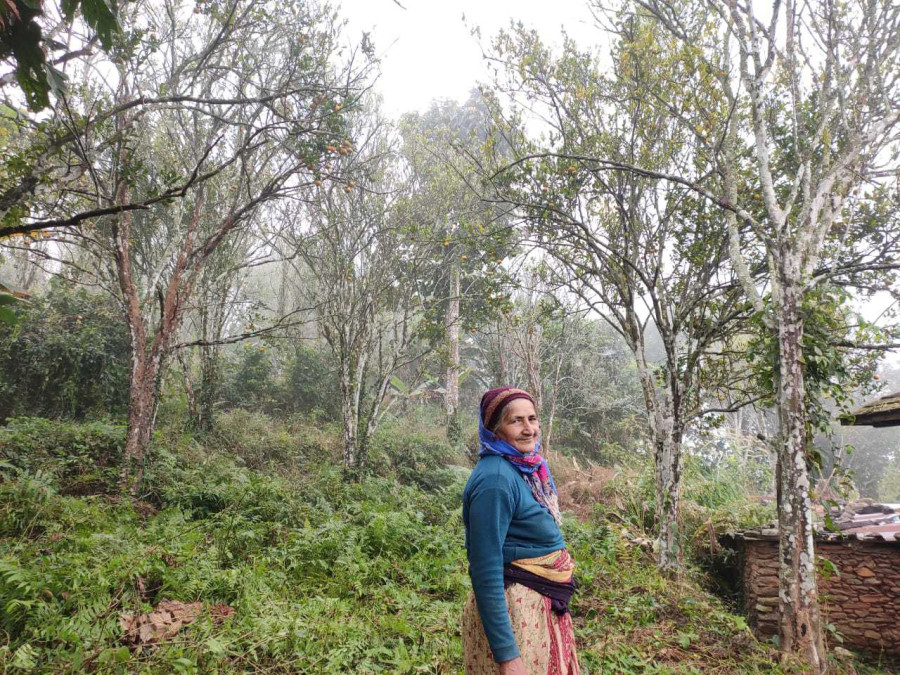Money
After diseased orange trees die, farmers worry about the loss of income and even migrate
Orange trees, which take four years to bear fruit, have been dying in Tanahun and neighbouring districts for lack of micronutrients.
Anup Ojha
It’s been five years since relatives more or less stopped coming calling at Ichha Maya Parajuli’s house.
It’s been five years since her 200 orange trees stopped bearing fruits.
“Now nobody comes here because oranges do not bear fruits and the trees are almost all dead,” said nostalgic Parajuli, 60, showing the feathered trees just in front of her stone roofed house in Pahari Dada of Vyas Municipality-8, Tanahun.
Relatives and other acquaintances from far and wide used to come from far and wide during November and December when the oranges ripened not only to eat them but also to take back bags full of them — as free gifts.
Even after distributing the sweet citrus fruit, planted on eight ropanis of slopes of her land she made Rs250,000 selling them at Rs25 per kg.
Had they continued to bear fruit, at current prices, she would have made over half a million, she says.
“My relatives call me only to inquire whether there are oranges, and when they hear there aren’t, they do not come,” she added.
Her son Rajendra, 44, is in Saudi Arabia and the daughter-in-law lives in Damauli, district headquarter, for her kids’ education.
Parajuli does not know the exact reason why the trees she cultivated a decade and a half ago with so much care have died.
“But agro experts said they say they are diseased,” said Parajuli.
It’s not only Parajuli’s trees but those of half a dozen households in Pari Dada, another dozen in Lamsal Gaun, over a dozen in Magar Jaubari, as well as in Bahun Pokhara, Korthok and other places the orange trees are dying.
Villagers who used to make a good income selling oranges from their farm have been deprived of this. And their relatives too, like those of Prarjuli, hardly come visiting.
The dying of orange trees has not only caused economic loss, it has also forced them to migrate from villages to the lower-lying areas from the hills of Tanahun.
Two years ago, Indra Bilash Neupane,70, a retired Nepal army migrated from Barlanchi in Tanahun to Chitwan along with his six family members.
“Five years ago I used to earn up to Rs 300,000 selling oranges from my farm, but after the orange trees started to die, our family shifted to Chitwan because life is difficult in the hills and hard to have a good income,” said Neupane. Now he has started a small cow farm in Chitwan.
However, Neupane has not permanently shifted to Chitwan, the lower land.
“I come here as still few orange trees are alive and bearing fruits,” said Neupane, when the Post met him in his farm last week. This time he earned only Rs 60,000, selling oranges at Rs50 per kg.
“If only those trees were not dead, I would have earned nearly a million in one season. I would not have shifted to Chitwan” said Neupane, who is also a chairperson of Krishi Suntala Samiti, formed by the villagers.
He had planted oranges in 12 ropanis of land with 300 trees.
Mahadev Prasad Paudel, senior agriculture economist and communication officer at Department of Agriculture in Kathmandu said orange trees are dying in different hills of Lamjung, Tanahun, Kaski and even in Gorkha due to citrus greening disease and lack of micronutrient.
“Such problems are seen in big orange farms in Bandipur and other areas too,” said Paudel. Besides that, the lack of manpower to take care of the orange trees as many youths have left the country for better earning is another reason the trees have died.
The department estimates that dying of orange trees have brought great loss to farmers but the government does not have data regarding the annual loss amount farmers are facing due to dying of orange farms.
When the Post contacted Santa Karki, chief at National Center For Fruits Development, she said that the only solution is to destroy all the old orange trees and plant fresh saplings and take good care of them.
“If that’s the case, the centre can send saplings and provide guidance to the farmers,” said Karki.
“Raising orange trees is also like taking care of women who gave birth to new babies,” she said. “The farmers need to be aware of this.”
But that is little consolation for farmers like Parajuli and Neupane.
“We are helpless here, because how can I cut those trees which I planted with so much care and what’s the assurance that those newly planted trees will bear fruits, without being diseased,” said Parajuli.




 18.12°C Kathmandu
18.12°C Kathmandu.jpg)















